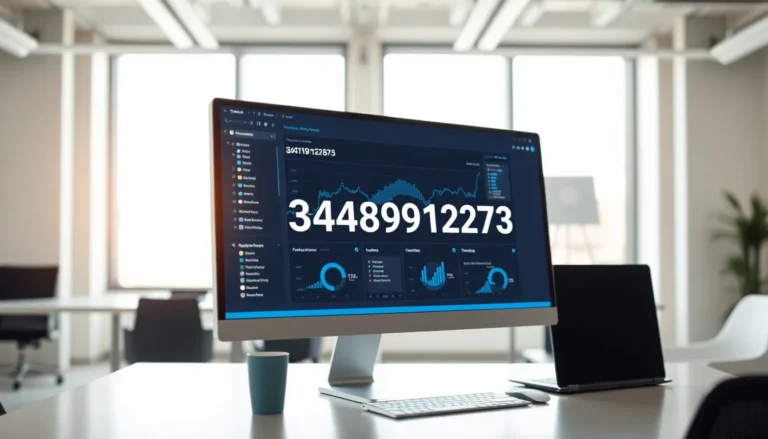Time management is crucial in today’s fast-paced world, and knowing how long until a specific time can make all the difference. Whether it’s planning a meeting, catching a train, or simply scheduling a break, the clock plays a vital role in daily activities. When someone asks, “How long till 1:15 PM?” they’re often looking for more than just a number; they want to optimize their time effectively.
Understanding the time left until 1:15 PM can help individuals make informed decisions and stay on track. It’s an essential skill that can enhance productivity and reduce stress. In this article, we’ll explore various methods to calculate the time remaining, ensuring that anyone can easily determine how long they have until that crucial hour strikes.
Table of Contents
ToggleUnderstanding Time Calculations
Calculating time intervals helps individuals manage their schedules effectively. Understanding the concept of time and recognizing its importance can significantly enhance productivity.
The Concept of Time
Time refers to the measurable period that events occur within. It consists of hours, minutes, and seconds, enabling structured planning. Time is divided into two main formats: 12-hour and 24-hour. The 12-hour format cycles through AM and PM, while the 24-hour format runs from 00:00 to 23:59. Knowing how to interpret these formats aids in understanding how much time remains until specific hours.
Importance of Knowing Time Intervals
Knowing the time remaining until a particular event, such as 1:15 PM, influences decision-making. Time intervals aid in prioritizing activities like meetings, travel, or breaks. For example, calculating time intervals helps individuals manage deadlines and allocate time for tasks efficiently. Consequently, awareness of these intervals reduces stress and promotes better time management.
How to Calculate Time Until 1:15 PM

Calculating the time until 1:15 PM involves straightforward methods that enhance planning and organization. Understanding these calculations can streamline daily schedules.
Step-by-Step Calculation Method
- Identify Current Time: Note the current hour and minute. For example, if it’s 10:30 AM, recognize that you start from this point.
- Convert Time to Minutes: Convert both the current time and 1:15 PM to minutes since midnight. For instance, 10:30 AM equals 630 minutes (10 hours x 60 minutes + 30 minutes), while 1:15 PM equals 795 minutes.
- Subtract Current Time from Target Time: Subtract the current time in minutes from 795. In this example, 795 – 630 equals 165 minutes.
- Convert Minutes Back to Hours and Minutes: Divide the result to find hours and minutes. For this instance, 165 minutes equals 2 hours and 45 minutes.
Visual Aids for Time Calculation
Visual aids can enhance understanding of time calculations. Consider these tools:
- Clock Diagrams: Diagrams showing analog clocks can visually represent time intervals, making it easier to understand how much time remains until 1:15 PM.
- Time Conversion Charts: Charts that outline conversions between hours and minutes help users quickly convert their current time to the target time.
- Countdown Timers: Utilizing apps or tools that provide countdown features can visually display time remaining, allowing for real-time tracking until 1:15 PM.
Employing these methods and tools improves accuracy in time management, aiding in structured daily planning.
Practical Applications of Time Calculations
Calculating time until a specific hour, like 1:15 PM, serves crucial functions in daily life. Understanding how much time remains helps enhance efficiency and organization in various scenarios.
Daily Planning and Scheduling
Daily planning relies heavily on accurate time calculations. Individuals utilize these calculations to structure their days better. For instance, knowing there are 45 minutes left until 1:15 PM can help prioritize tasks, such as completing a presentation or preparing for a meeting. Timely scheduling assists in balancing work with personal commitments, ensuring a seamless flow of activities. People often set reminders based on these calculations, which aids in maintaining punctuality and reduces the chance of overcommitting.
Time Management Skills
Effective time management stems from precision in time calculations. By understanding remaining time, individuals can allocate minutes wisely. This skill applies to various settings, such as professional environments and personal life. For example, students can gauge how long to study or complete assignments effectively. Adults can manage work tasks, deadlines, and personal projects more efficiently by leveraging time awareness. Developing these skills leads to increased productivity and less stress, making it essential for success in today’s fast-paced world.
Common Mistakes in Time Calculations
Time calculations often lead to errors that can disrupt daily schedules. Recognizing these mistakes helps individuals enhance their time management skills.
- Ignoring AM/PM Designation: Confusing morning and afternoon times affects schedules. For instance, mistaking 1:15 PM for 1:15 AM can lead to missed appointments.
- Failing to Account for Time Zones: Not considering differing time zones can create misunderstandings. Scheduling a meeting at 1:15 PM Eastern Time without converting to the local time for participants may cause confusion.
- Miscalculating Minutes and Hours: Overlooking minute conversions leads to inaccurate assessments. For example, miscalculating the time remaining until 1:15 PM from 12:50 PM results in an incorrect 25 minutes rather than the correct 25 minutes.
- Neglecting Daylight Saving Time Changes: Forgetting to adjust for Daylight Saving Time can result in scheduling conflicts. A meeting planned just after the time change may occur at a different hour than intended.
- Not Using Timers or Alarms: Relying on memory alone can lead to missed timeframes. Setting a timer for critical tasks helps ensure adherence to schedules.
- Ignoring Contextual Clarity: Failing to clarify time with regard to the current day can complicate plans. Stating 1:15 PM without specifying the date might confuse events occurring on multiple days.
Addressing these common mistakes facilitates better time management and reduces stress related to scheduling and commitments.
Understanding the time remaining until 1:15 PM can be a game-changer for effective time management. By mastering the art of calculating time intervals and utilizing helpful tools, individuals can streamline their daily routines. This knowledge not only enhances organization but also empowers people to prioritize tasks more efficiently.
Avoiding common pitfalls in time calculations is crucial for maintaining a stress-free schedule. With these strategies in place, anyone can improve their productivity and find a better balance between work and personal commitments. Embracing these time management skills is essential for thriving in today’s fast-paced environment.








